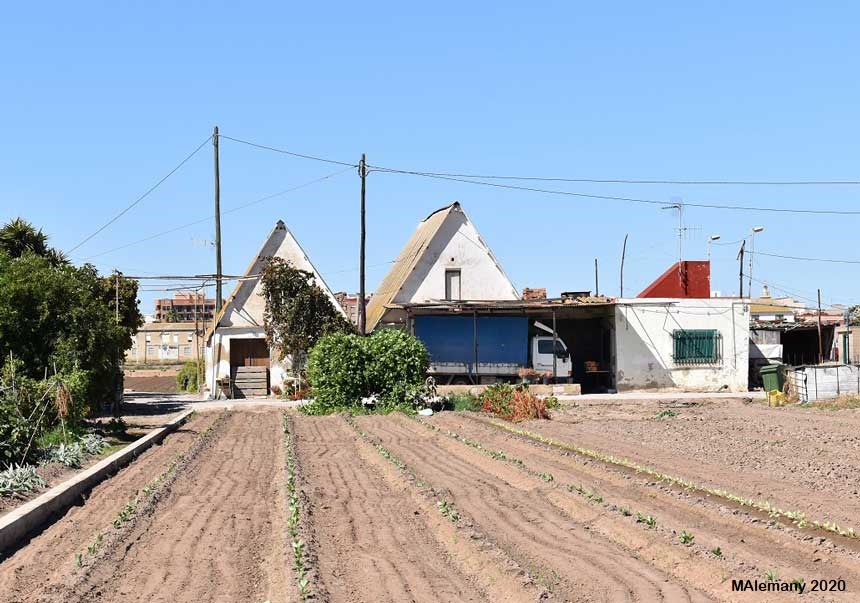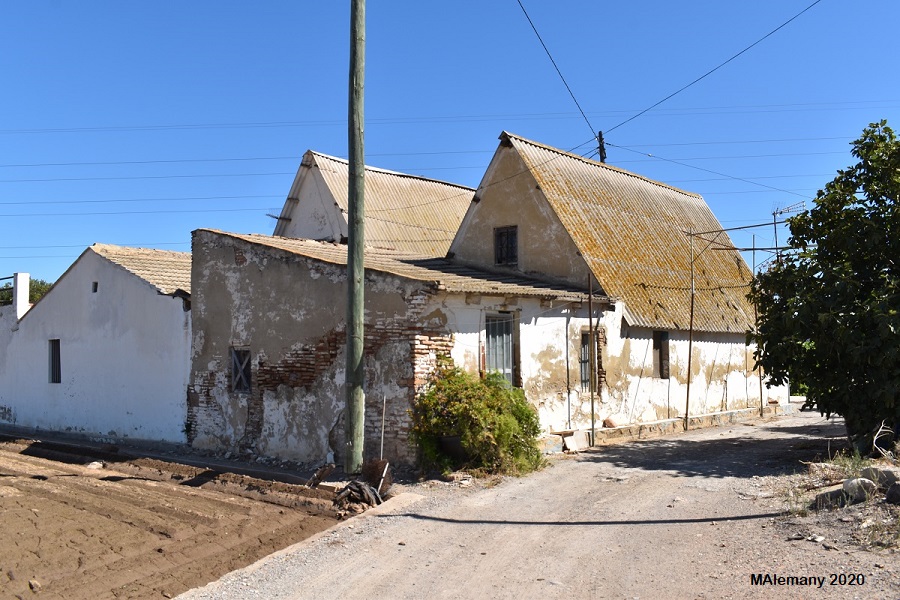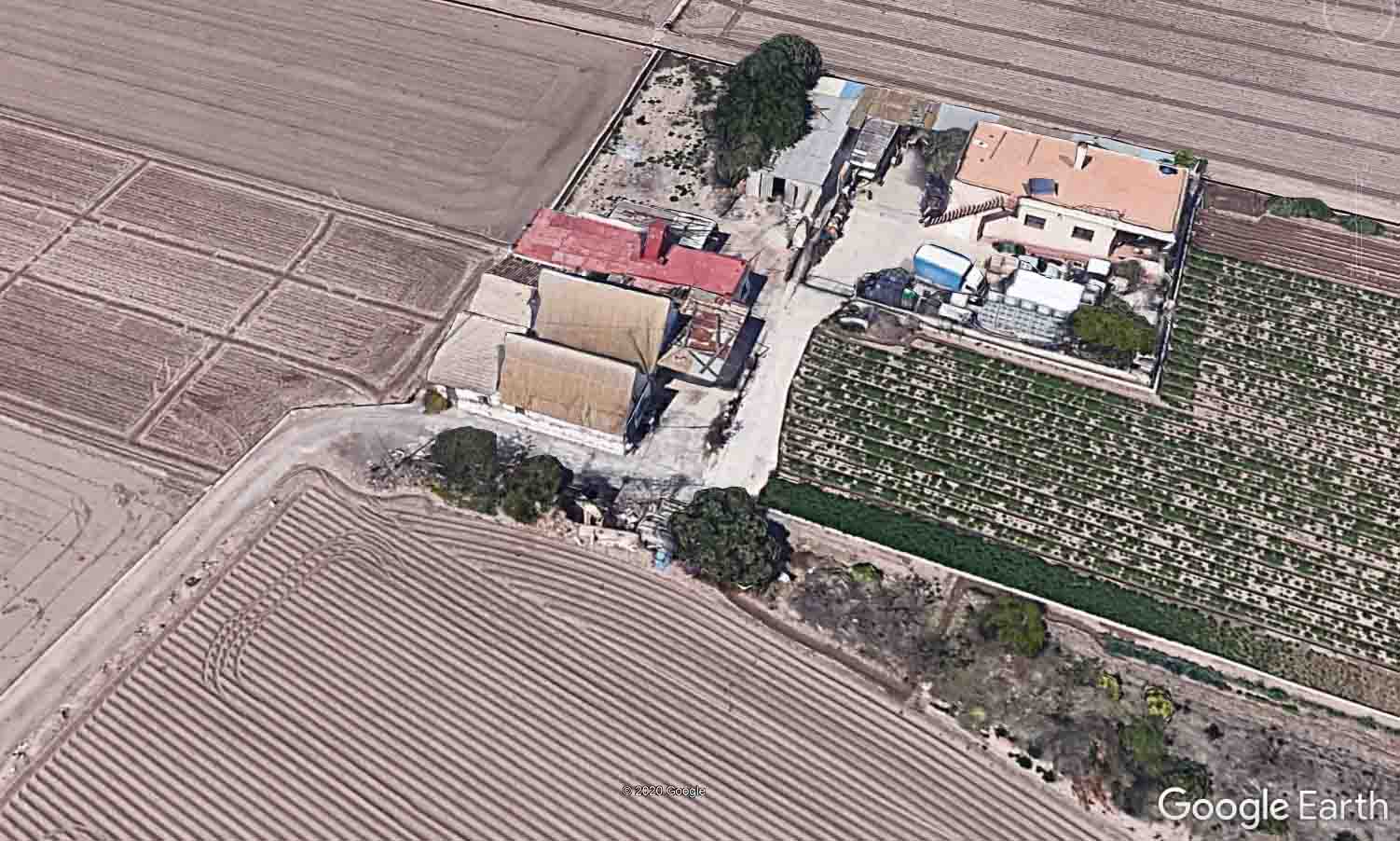
They are located on the Partida Calvet road no. 37, also known as the Sastre road no. 61. They can be reached from the town of Alboraia, via an entrance to the Ronda Est (East Ring Road) of the city located at the height of the town's Ausiàs March avenue. They are about 650 m (2132ft 6.5in) from this entrance, on the left-hand side of the road, towards the sea.
These barraques (huts) have been the object of successive interventions which have modified part of their structure and roof. Other additional buildings have also been attached to them.
18th or 20th centuries.
According to J. A. García Esparza (2012) they are 18th century barraques (huts), three hundred years old, although the Revision of the General Town Development Plan of Alboraia (2012) states that they date from 1910. Clearly their appellative is a nickname of the family who lived in the 20th century and, in the second case, that of their recent owner. Nevertheless, as in the case of many of these popular buildings in l’Horta (the irrigated land of València), it is not easy to give a more concrete chronology. As in the periphery of the city of València as a whole, many of these barraques were built during the 19th or early 20th century, even with possible major modifications on the same site. These barraques do not usually appear in the documents of the past centuries in an identifiable form by names or place names, while at an oral level they were usually known in their surroundings by the name or nickname of the people who owned or lived there. For this reason, the name of the barraca (hut) was frequently modified due to the change of residence of these people, and it is difficult to determine the specific history of the owners, works, etc., without family witnesses or neighbours.
These barraques (huts) are still preserved in an irrigated area of Alboraia not too affected by urban growth. According to the Revision of the General Urban Development Plan of Alboraia (2019), this is one of the few remaining examples of paired barraques. This was a practical solution that became widespread in the 19th and early 20th centuries to carry out the spatial growth of the first barraca (hut) due to the need to extend the living space. They were joined by a small, covered passageway and, normally, the uses were divided between them: one for the living room and bedrooms, and the other for the kitchen and stables. In fact, spatial growth could continue, as in this case, with the annexation of new, more modern constructions for agricultural storage and other uses. It could also evolve to generate two individual barraques in two separate dwellings. All these changes have also affected the ensemble in this case, in such a way that there are currently several buildings of little architectural value attached to them, as well as the opening of new windows and doors. According to J. A. García Esparza (2012), these barraques are built of brick and painted on the outside. They still have wooden beams, although, as usual, the traditional roofing has been replaced by corrugated fibre concrete sheeting. The ground plan of the two buildings is rectangular, with a surface area of approximately 46 m2 (495.1ft2) each. The width of the façade is 4.96 m (16ft 3.2in), while the depth is 9.25 m (30ft 4.1in) in length and the height is 6.30 m (20ft 8in). The two are equipped with electricity and well water connections.
Asset of Local Relevance according to the Revision of the PGOU of Alboraia (2019). It is not included in the PAT of l’Horta.
- Proyecto de Revisión del PGOU de Alboraia. Plan General Estructural de Alboraia. Catálogo de Protecciones Estructural. Fichas individualizadas del Catálogo Estructural. 2019.
- Hernández Dolç, Agustí, “Les barraques de l’Horta Nord. Un últim vestigi d'un temps passat”, Revista Métode, n. 32 (hivern 2001-2002).
GARCÍA ESPARZA, J. A.(2012): Barracas del litoral mediterráneo. Catálogo de Valencia y su entorno, Castelló, Publicacions de la Universitat Jaume I, pp. 198-199.
DEL REY, M. (2010): Arquitectura Rural Valenciana, Barcelona: Galerada (1ª edició: València: Direcció General de Patrimoni Artístic, 1996).
GARCÍA ESPARZA, J. A. (2008): “La barraca valenciana, procesos de transformación”, Revista valenciana d'etnologia, n. 3, pp. 145-159.
CRUZ OROZCO, J. (2003): “Las viviendas de cubierta vegetal en el territorio valenciano: el caso de la barraca”, Revista El Pajar: Cuaderno de Etnografía Canaria, n. 14, pp. 111-116.
SANCHIS GUARNER, M. (1957): Les barraques valencianes, Barcelona, Ed. Barcino (reedició: València, Institució Alfons el Magnànim, 1999).
ALAMELA VIVES, F. (1960): La vivienda rural valenciana, Valencia, La Semana Gráfica.
CASAS TORRES, J. M. (1944): La vivienda y los núcleos rurales de la huerta de Valencia, València, Diputació Provincial de València.
RUIZ RUBIO, J. V. (1999): Construint una barraca valenciana, València, Ajuntament d’Alboraia-Col·legi d’Aparelladors i Arquitectes Tècnics de València-Col·legi d’Arquitectes de la Comunitat Valenciana.
GOSÁLVEZ, V.(1915): Estudio constructivo de la Barraca de la Vega Valenciana, Tema de investigación presentado al tribunal de oposiciones. Manuscrito. Biblioteca del COAV. València (Facsimil de: “La Barraca Valenciana”, COACV-Colegio Oficial de Arquitectos de la Comunidad Valenciana, 1998).
Photos: M. Alemany, Google Street View
















